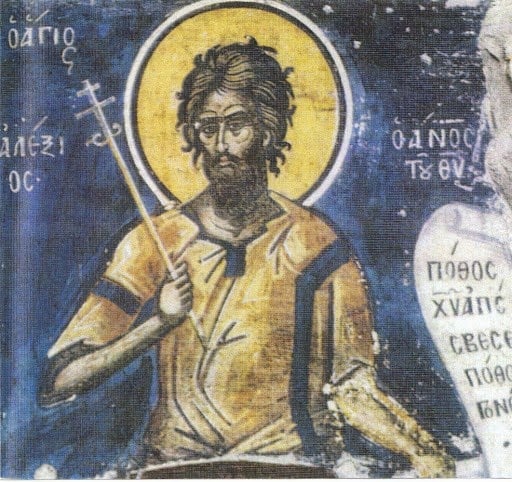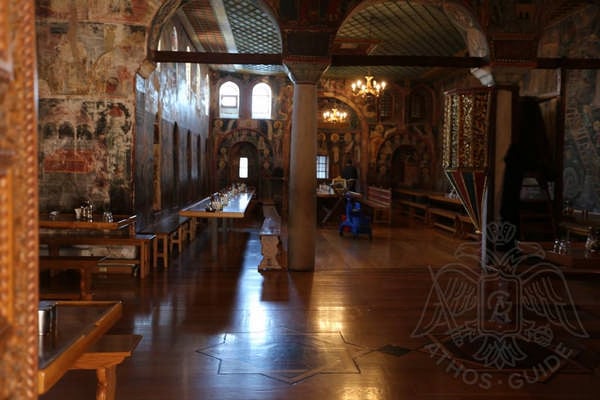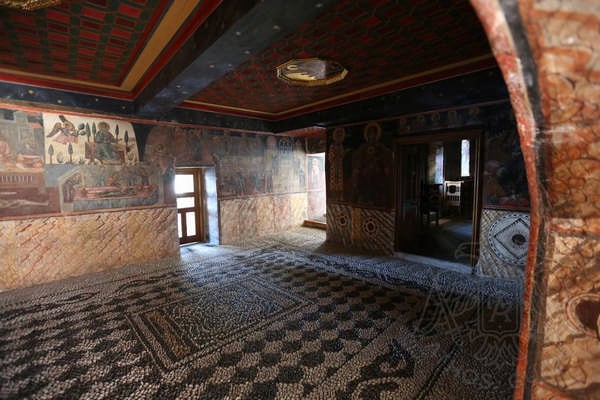
Tzortzis was a Cretan artist of the 16th century. Although we do not know much about his life, his origins demonstrate the traditional byzantine and venetian influences he received. He was a pupil of Theophanes the Cretan, who taught him the art of iconography and shaped his artistic style. Several works in the mainland Greece are attributed to him. However, we only know of his presence and activity through written sources and historical evidence, as his works were left unsigned.
Tzotzis is one of the most important representatives of the early post-byzantine painting. His oldest known work is the fresco of Dionysiou Monastery in Mount Athos. According to a manuscript dating from 1634 (no. 64), 'George the Cretan' was the iconographer of the monastery. The Katholikon and a part of the altar were painted in 1547, with the inscription 'this painting was done by a great teacher, Mr George from Crete'.
Frescos of religious art in Meteora, that date back to 1560, are also attributed to Tzortzis.
He is considered to be one of the most important representatives of the early post-Byzantine painting, equal, as many claim, to Theophanes the Greek. His works belong stylistically to the so-called 'Cretan school' of iconography. A characteristic feature of his technique is the use of dark and intense colors. His figures are characterized by rigor and plasticity, so that they appear three-dimensional and alive.
The Cretan school and its influence
The Cretan school not only preserved the byzantine artistic tradition, but also represented a stylistic progress in byzantine art. The works produced are both traditional and innovative. Historians call this trend "Cretan", mainly because of the predominance of Cretan artists.
What is particularly surprising is the creative survival of this style, which developed despite the political and social context of that time. The Greek population was under the Ottoman rule and, consequently, under the control of Muslim conquerors.
Indeed, iconography is "an inexhaustible source of inspiration to which we can turn at any time .... it is a rhythmic force, unaffected by time".
After 1453, the Greek territory was divided between the Turkish conquerors (mainland Greece) and the Venetians (islands). From then on, Orthodoxy was the factor that distinguished the winners from the defeated. Therefore, the role of the Church was particularly important for the enslaved Greek population..jpg)
The replacement of the idea of national identity by religion is the reason why the iconography of that period was transformed from religious art into a national visual language.
The frescoes of Dionysiou Monastery
Dionysiou Monastery is located on the southwestern side of the peninsula. It was founded in the second half of the 14th century by Saint Dionysios and consists of fourteen chapels. The Katholikon of the monastery, dedicated to Saint John the Baptist, was built shortly before the middle of the 16th century. The monastery experienced periods of great prosperity, while its cultural heritage has been preserved in perfect condition, as it has never suffered from fires or other disasters.
The mural decoration
The frescoes of the monastery are based on the Revelation of Saint John the Theologian (probably painted during 1560-1564). The scenes from the Revelation were usually placed on the west wall of the church, opposite the altar. The believer would encounter them on his way out, as a reminder of the Last Judgement. However, at Dionysiou Monastery, the Revelation was illustrated on the outer wall of the altar.
This is the only extensive depiction of all the events of the Revelation.
The 20 illustrated scenes represent the respective chapters, exactly as described by Saint John the Theologian.
Refectory
Below you may find a description of the scenes from the last book of the New Testament. In each depiction the iconographer added passages from the Revelation of St. John written in capital letters.
 Some of the scenes depicted in the frescoes are described as follows:
Some of the scenes depicted in the frescoes are described as follows:
- The Revelation of Jesus Christ to the Apostle John. The Lord appears to the evangelist John and reveals to him the truth about the last days before the end of mankind. Christ is depicted standing on a cloud, clothed in a golden robe, with his right hand raised and holding seven stars, symbols of the bishops of the seven churches. Christ is surrounded by seven lighted lamps, representing the seven churches of Asia Minor.
- God enthroned, the praise, the sealed book and the Lamb of Zion. In this scene we see the beginning of the Revelation, the breaking of the first seal of the book of Judgment. Jesus is being hold by angels. The four Evangelists are traditionally depicted in their symbolic forms, the angel, the lion, the calf and the eagle. Higher up there are seven torches representing the Holy Spirit. The lamb as a symbol of Jesus Christ has the power to open the Book of Judgement, where all the past, present and future events are recorded. The lamb has seven horns and seven eyes, according to the number of the Old Testament prophets. When the lamb opens the seven seals, the voices of the four evangelists are heard: "Come and see."
- The four horsemen of Revelation. Each horseman sits on a horse of a different color. The horsemen are biblical characters associated with a series of tragic events that take place before the Second Coming and the time of judgment. Their description is in the sixth chapter of the Revelation. The first one, mounted on a white horse, is identified with the Plague. Behind him there is War. He is mounted on a red horse and holds a sword in his hands. Next there is Hunger on a black horse. The procession closes with Death's pale horse.
.jpg)
- 144,000 servants. "And I saw another angel coming out of the sunrise holding the seal of the living God. He cried out with a loud voice to the four angels who had been commanded to harm the earth and the sea, saying: Do not harm the earth, nor the sea, nor the trees, until we have set the seal on the foreheads of the servants of our God. And I heard the number of the sealed – they were 144,000 of all the tribes of the children of Israel."
- The fifth trumpet. It is a shocking fresco depicting winged monsters with human heads falling from the sky. Perhaps these are demons released to torment those humans who do not have the seal of God on their foreheads.
- The two beasts. One of the central figures is the false prophet, who emerges from the earth taking the form of a lamb. He is the so-called "prophet" of Antichrist. This lamb deceitfully misleads humanity, luring it to the side of the coming Antichrist. The next beast, having many heads, emerges from the sea.
- The seven angels. The seven angels give a final chance to the human race to repent of their sins and be saved.
- The great prostitute and the beast. This fresco depicts the beast on which a prostitute is sitting. Opinions vary as to the symbolism of this depiction. Some church fathers have argued that it is an allegory of ancient or 'new' Rome, the city of the seven hills. A second version presents the prostitute as a symbol of the apostate church.
- The victory of the horseman with the white horse. The fresco depicts a battle between the "red" and "white" horsemen. On the head of one of the horsemen there is an angel in the form of a warrior. According to the corresponding inscription, this is the 'Word of God'.
 His head is crowned, while a sword comes out of his mouth. His soldiers repel the enemy's attack and throw him into a burning lake. Predatory white birds are also helpers of the angelic army. They descend from the sky and scatter the bodies of the Antichrist's soldiers. The result of the battle is the death of the dragon with the seven heads.
His head is crowned, while a sword comes out of his mouth. His soldiers repel the enemy's attack and throw him into a burning lake. Predatory white birds are also helpers of the angelic army. They descend from the sky and scatter the bodies of the Antichrist's soldiers. The result of the battle is the death of the dragon with the seven heads. - The angel and the defeated Satan. "And I saw the angel descending from heaven, holding the key to the abyss and a great chain in his hand. He took the dragon, which is the devil and Satan, and bound him for a thousand years, and cast him into the bottomless pit, and imprisoned him, and put a seal upon him, so that he would no longer deceive the nations, until the thousand years would come to an end. Then he would be set free again for a little while.” The angel in the fresco occupies a central position. The key in his right hand is designed to open and close the door of the abyss. The chain that holds the Satan is red.

